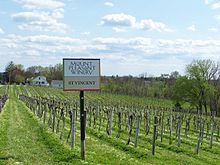Augusta AVA
| Augusta AVA | |
|---|---|
 View of the Augusta AVA as seen from the Montelle Winery. |
|
| Appellation type: | American Viticultural Area |
| Year of establishment: | 1980 |
| Country: | United States |
| Part of the wine-growing region: | Missouri , Ozark Mountain AVA |
| Recognized cultivation area: | 3900 hectares (15 sqmi) |
| Grape varieties: | Cabernet Sauvignon , Chambourcin , Chardonel , Chardonnay , Couderc Noir , Norton , Rayon d'Or , Seyval Blanc , St. Vincent , Vidal Blanc , Vignoles |
Augusta AVA is a wine-growing region in the US state of Missouri that has been recognized by the Bureau of Alcohol, Tobacco, Firearms and Explosives since June 20, 1980 . It is the oldest American Viticultural Area in the United States and was defined eight months before the very famous Napa Valley AVA in northern California.
location
The vineyards are spread over areas near the eponymous city of Augusta at the intersection of the boundaries of the administrative units of St. Charles County , Warren County and Franklin County . The area is approximately 60 km west of St. Louis on the Missouri River . The area is known for the river meadows and alluvial land.
history
The area around Augusta was settled by Europeans in 1836. The current city of Augusta was founded by Leonard Harold, from the entourage of Daniel Boone , as a boat mooring on the Missouri. Augusta's original name was Mount Pleasant and the boat dock was called Augusta Bend. In 1855 the settlement got its current name. Four years later, Georg and Friedrich Muench laid the foundation stone of the Mount Pleasant Winery, which still exists today. In 1872, a flood changed the course of the Missouri River. The former boat landing stage silted up and offered areas for new vineyards on the alluvial land. Viticulture flourished in the region in the late 1880s through the early 20th century, and Missouri wine was delivered to the eastern reaches of the Rocky Mountains . However, prohibition brought viticulture to a complete standstill and it was not until the early 1960s that new plantings were made. A number of the wineries that exist today date from this time.
The region's wines have also been available in Germany since 2003 and have already received good marks in the German wine magazine Selection from Mainz .
Grape varieties

The Augusta AVA is now planted with some European noble vines such as the Cabernet Sauvignon , Chardonnay and Merlot varieties . The most important grape variety remains a descendant of the wild grape Vitis aestivalis , the Norton grape variety . However, the French hybrid grapes Chambourcin , Chardonel , Couderc Noir , Rayon d'Or , Seyval Blanc , St. Vincent and Vidal Blanc are also very popular.
Web links
- Augusta AVA (in English) - Appellation America
- Augusta Wine Country (in English)
- Wineries in Augusta (in English)
See also
Individual evidence
- ^ Code of Federal Regulations. "§ 9.22 Augusta." ( Memento of February 12, 2012 in the Internet Archive ) Title 27: Alcohol, Tobacco and Firearms; Part 9 - American Viticultural Areas; Subpart C - Approved American Viticultural Areas. Last access to this page on October 19, 2008.
- ↑ a b T. Pingelton The Soul of Augusta Article of December 8, 2005 on the English-language page Appellation American
- ^ Appellation America (2007). "Augusta (AVA): Appellation Description" . Last access to this page on October 19, 2008.
- ↑ B. Durfur: Exploring Missouri Wine Country , page 43, Pebble Publishing 2007 ISBN 1-891708-30-9
- ^ H. Johnson & J. Robinson The World Atlas of Wine page 269 Mitchell Beazley Publishing 2005 ISBN 1-84000-332-4
- ↑ B. Durfur Exploring Missouri Wine Country , page 35, Pebble Publishing 2007, ISBN 1-891708-30-9
- ↑ B. Durfur Exploring Missouri Wine Country , page 37, Pebble Publishing 2007, ISBN 1-891708-30-9
- ^ A. Garfunkel, "Norton: Missouri's State Grape Harbors Juicy Little Secrets," Sauce Magazine, June 1, 2004
literature
- André Dominé : Wine . 1st edition. Tandem Verlag, 2007, ISBN 978-3-8331-4344-1 .